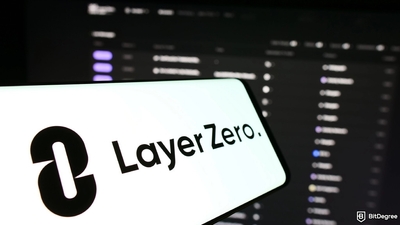Key Takeaways
- Knowing how to short crypto is a strategy that can help diversify your trading and potentially increase your profits.
- Staying informed and up-to-date with market trends is crucial to short crypto effectively and securely.
- Always implement risk management strategies to avoid significant loss on your investment.
Free Airdrop Season 7 is LIVE! Answer fun questions or do simple tasks to earn rewards from the $30K BitDegree prize pool. Participate Now ! 🔥
Knowing how to short crypto is an essential skill for every trader. It lets you make money even when the prices of cryptocurrencies are falling. This can be a great way to balance your investments because you're not only relying on prices going up to earn profits.
However, shorting crypto also comes with risks. Therefore, knowing the proper strategy behind short-selling cryptocurrencies is important to ensure you’re not falling into the loss pitfall. In this article, I will show you how to short crypto, including the basic steps and some advanced strategies.
We will also look at some of the best crypto exchange platforms where you can short crypto, including Binance, Kraken, and Coinbase.
A quick disclaimer before we start, this article is not financial or investment advice. The crypto market is still new and highly volatile, so you shouldn’t take any info I present here as a rule of shorting crypto. Always consult your financial advisor before making any investment. With that being said, let’s take a look at the step-by-step guide on how to short crypto.

Did you know?
Subscribe - We publish new crypto explainer videos every week!
What is Ethereum 2.0? Upgrades Easily Explained With Animations


Table of Contents
- 1. How to Short Crypto: A Step-by-Step Guide
- 1.1. Choosing a Trading Platform
- 1.2. Setting Up and Funding Your Account
- 1.3. Identifying Shorting Opportunities
- 1.4. Executing a Short Trade
- 1.5. Managing and Closing the Position
- 2. Advanced Short Selling Strategies
- 2.1. Using Futures Contracts to Short Crypto
- 2.2. Options Trading as a Method to Short
- 2.3. The Use of Leveraged Tokens
- 3. Understanding the Basics of Short Selling
- 3.1. Definition and Mechanics of Short Selling
- 3.2. Risks and Rewards of Short Selling Crypto
- 3.3. The Role of Market Sentiment and Analysis
- 4. Risk Management in Short-Selling Crypto
- 5. Conclusion
How to Short Crypto: A Step-by-Step Guide
Shorting crypto can be a rather complex process, but you don’t need to worry. In this section, I will show you the necessary steps, starting from choosing the right trading platform up until you’re ready to execute a short trade.
Latest Deal Active Right Now:Head to BitDegree Missions, gather as many Bits as possible & claim your stake of the $30,000 Prize Pool! Don't waste your time & start collecting Bits by completing Missions and referring friends.
Choosing a Trading Platform
When you're learning how to short crypto, choosing the right exchange platform is crucial. Not all platforms allow short selling, so finding one that does is the first step. Besides allowing you to short, top platforms offer features like leverage options, competitive fees, and strong security measures.
Let's look at Binance, Kraken, and Coinbase to understand how they differ in terms of short-selling capabilities and features.
- Binance: Known for its wide range of cryptocurrencies and features, Binance offers options for shorting crypto through futures and margin trading. It provides leverage, which means you can borrow money to increase your potential return (but also your risk). Binance is popular for its low fees and robust security, making it a go-to for traders looking to short-sell.
- Kraken: Kraken allows short selling on a variety of cryptocurrencies and is known for its comprehensive security measures. It offers leverage up to 5x for certain trades, which is attractive for those looking to amplify their short-selling efforts. Kraken's fees are competitive, and its platform is designed to cater to both beginners and experienced traders.
- Coinbase: While Coinbase is one of the most user-friendly and secure platforms, its options for shorting crypto are more limited compared to Binance and Kraken. Primarily known for buying and holding cryptocurrencies, Coinbase is more suitable for beginners and long-term investors rather than those looking to actively short-sell.
Beyond just shorting capabilities, it's crucial to consider factors like user experience, security, fees, and available assets when choosing an exchange. This ensures you select a platform that aligns with your overall trading goals and risk tolerance.
Setting Up and Funding Your Account
After you choose the exchange platform, it is time to make an account. In this tutorial, I'm going to use Binance as an example. Here’s a simple step-by-step guide to get you started:
Step 1: On the Binance homepage or mobile app, look for a button or link that says 'Sign Up' or 'Create Account'. It's usually at the top right corner of the page.
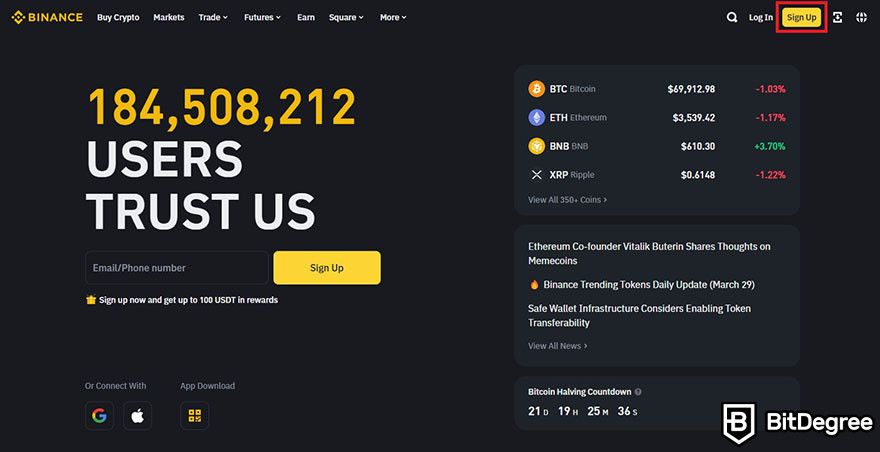
Step 2: You will be asked to provide some basic information, such as your email address or mobile number, and to create a password. Make sure your password is strong and unique to protect your account.

Step 3: After submitting your details, Binance will send you a verification code via email or SMS. Check your inbox or messages, and enter the code on the Binance website to confirm your identity.
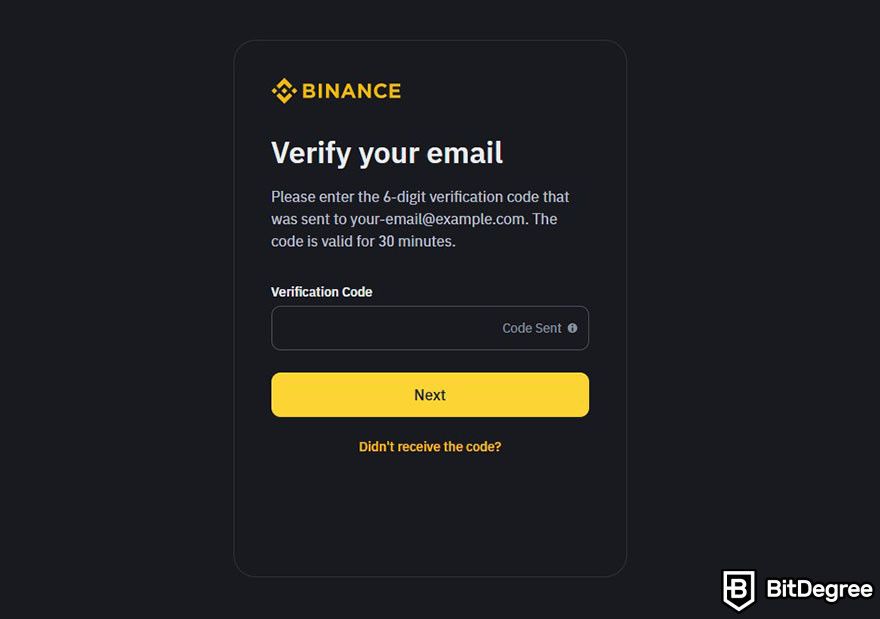
Step 4: Set up security features: Binance will ask you to set up some security measures, like Two-Factor Authentication (2FA). This could be through a text message, an email, or an authentication app. It adds an extra layer of security to your account.
Step 5: To use all the features on Binance, including short-selling crypto, you need to complete the Know Your Customer (KYC) process. This involves uploading identification documents, such as a passport or driver's license, and possibly a selfie for facial verification.
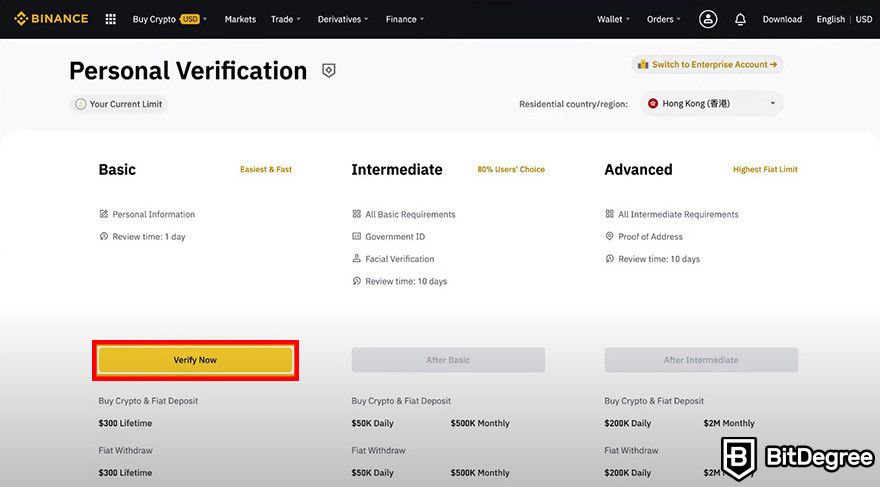
Step 6: Once your account is set up and verified, you can deposit funds into it. Go to the 'Deposit' section, choose your preferred method of deposit (e.g., bank transfer, or credit card), and follow the instructions to add money to your Binance account.

Step 7: With your account created, verified, and funded, you're now ready to start trading. While this guide doesn't cover how to short-sell crypto specifically, Binance provides tutorials and resources to help you learn trading strategies.
Creating an account on Binance mostly follows the same steps everywhere, but there can be some differences depending on where you live. This is because each country has its own rules about who can trade, what you need to show to prove your identity (like more documents for some places), how you can put money into your account, and what you're allowed to trade.
For example, in some countries, Binance might ask for extra papers or information to check who you are. The ways you can add money to your account, like through a bank transfer or using a credit card, might not be the same everywhere because of different banking rules.
Also, not all features, like using futures for short selling, are available in every country. Sometimes, the laws of a country can limit or even stop you from trading certain cryptocurrencies or using specific features such as borrowing money to trade.
So, remember to check if there are any special rules or limits in your country before you start creating an account and short-selling crypto on these platforms.
Identifying Shorting Opportunities
Now that you have an exchange account, you might wonder: 'Can you short Bitcoin and other cryptocurrencies with just an account?' Well, the answer is yes, but you'll need to use some tools and information to pick the right moment to short. Here are the three main techniques and tools you want to choose to identify shorting opportunities:
- Technical analysis: This is like looking for patterns in the price charts of cryptocurrencies to guess where they'll go next. On Binance, you can find these charts by selecting the cryptocurrency you're interested in and then clicking on 'TradingView' or 'Original' to see the charts. Look for trends like prices going up or down sharply, which might tell you if the crypto is about to change direction.
- News: Stay updated with the latest news on cryptocurrencies. Big news, like a country banning crypto or a big company investing in it, can quickly change prices. If you hear bad news about a cryptocurrency, it might be a good time to think about shorting it.
- Market trends: This is about feeling the mood of the market. Are people getting scared and selling their crypto, or are they excited and buying more? Sometimes, just the overall mood can give you a hint about whether it's a good time to short a cryptocurrency.
Executing a Short Trade
We’ve reached the core of our discussion, which is placing a short order. As I mentioned earlier, Binance offers options for shorting crypto through margin and futures trading. Here is the step-by-step guide on how to do each option:
Shorting Crypto With Margin Trading
Step 1: Log into your Binance account, click "Assets" and select "Margin."

Step 2: Find USDT by searching for it. Then, click on "Transfer."

Step 3: Enter the amount of USDT you want to transfer from your spot wallet to your margin wallet and confirm the transfer.
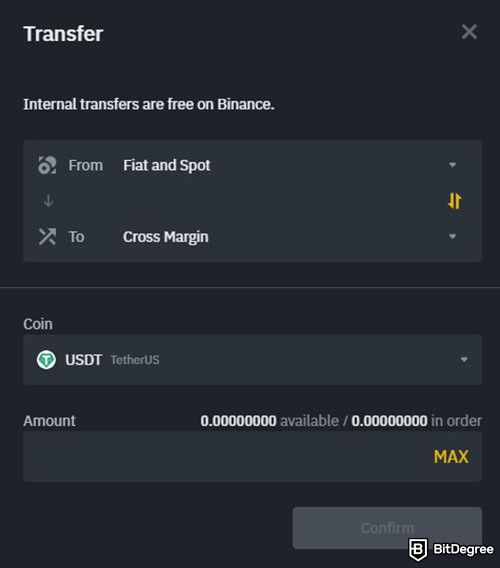
Step 4: Search for the cryptocurrency you want to short in the Margin Wallet, like BTC for Bitcoin. Click on "Trade" and select a pair, such as BTC/USDT.
Step 5: Go to "Sell BTC," which you can find under the price chart.
Step 6: Click on "Borrow" to see the maximum BTC amount you can borrow for shorting.
Step 7: To place your short sale order, specify the BTC amount you plan to short and click on "Margin Sell BTC."
Shorting Crypto With Futures Trading
Step 1: Activate your Futures account in the app to start trading options.
Step 2: Go to the "Trades" tab and select the "Options" button. Transfer funds to your Futures wallet if needed.
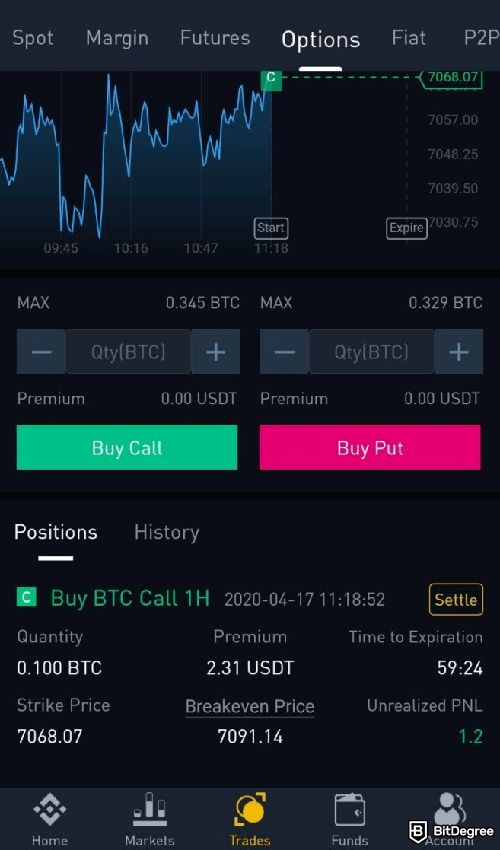
Step 3: Choose your expiry time from options like 10 minutes, 30 minutes, 1 hour, 8 hours, or 24 hours.
Step 4: Specify the contract size in the "Quantity" field and click on "Buy Call."
Step 5: A confirmation window will pop up. Review the details and click "Confirm."
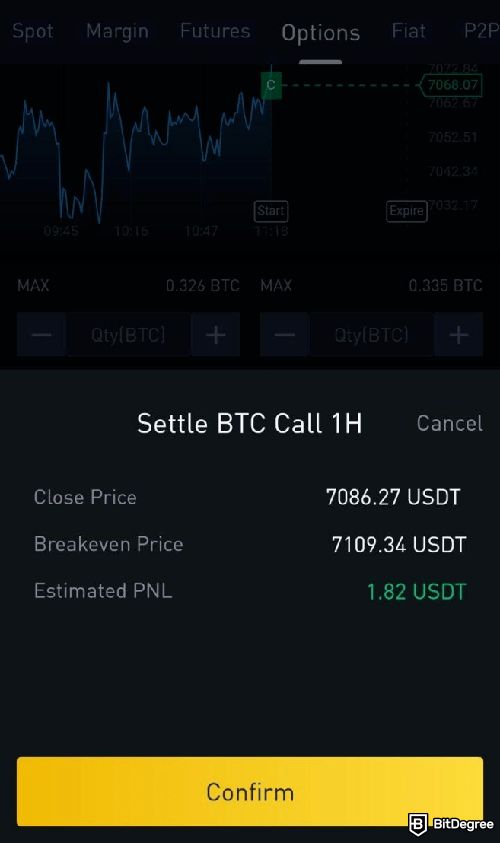
Step 6: Check your open positions in the "Positions" tab.
Step 7: To close a position, click on "Settle" next to the position you wish to close and then confirm your action.

Did you know?
Subscribe - We publish new crypto explainer videos every week!
What is Ethereum Classic & ETC Coin? (Animated Explainer)


Managing and Closing the Position
When learning how to short crypto, it's crucial to know when to exit your trade to either grab some profit or stop a loss from growing. Here are a few potential scenarios where you might decide to close your short position:
- Profit scenario: Let's say you short Bitcoin at $40,000, predicting it will drop. If the price falls to $35,000, you've made a good profit. It might be a good time to close your position and enjoy your earnings before the market changes direction.
- Loss scenario: If you short Bitcoin at $40,000 but the price rises to $45,000, you're facing a loss. To avoid bigger losses, consider closing your position. It's better to stop the loss early than hope the market will turn back in your favor.
Remember, the crypto market is unpredictable. Prices can skyrocket or plummet quickly because of news, market trends, or other traders' actions. Always be ready to act based on your initial plan, whether that's taking your profit sooner than expected or cutting your losses before they grow too large.
I encourage you to consult with a professional financial advisor who can provide you with valuable advice tailored to your situation before making any trading decision.
Advanced Short Selling Strategies
As I mentioned earlier, the crypto market is highly volatile, and prices can either skyrocket or drop down in a short period. So the question is: Can you short crypto without taking too much risk? Well, you can try to mitigate the potential loss by implementing the right strategy for your short-selling process. Here are three advanced ways to avoid getting a big loss while shorting crypto.
Using Futures Contracts to Short Crypto
Futures contracts are agreements to buy or sell a particular asset, like cryptocurrency, at a predetermined price on a specific future date. Here’s how to short crypto using futures contracts:
When you think a cryptocurrency’s price will drop, you enter into a futures contract to sell the crypto at today's price, but the actual exchange happens in the future.

If your prediction is correct and the price falls, you can buy the cryptocurrency at the lower price in the market, then sell it at the higher price you locked in with the futures contract. The difference between these prices is your profit.
For example, if you believe the price of Bitcoin will decrease, you might enter a futures contract to sell Bitcoin at its current price of $20,000 in a month. If, in a month, the price drops to $15,000, you can buy Bitcoin at this lower price and fulfill your contract, making a $5,000 profit per Bitcoin (minus any fees).
However, it's important to remember that if the price moves against your prediction, you might face losses. It's essential to have a deep understanding of futures and solid market analysis skills before proceeding.
Options Trading as a Method to Short
Options trading is a way to bet on the future price of a cryptocurrency without actually owning it. In options trading, you buy the right to sell or buy a crypto at a specific price in the future. Put options, in particular, are a tool for those wondering how to short crypto.
When you buy a put option, you're buying the right to sell a cryptocurrency at a set price before the option expires. If you think the crypto price will go down, you can use a put option to lock in a higher sell price now.

Here's how to short crypto with put options: Imagine you believe that the price of Bitcoin will drop. You buy a put option that allows you to sell Bitcoin at $20,000 anytime in the next month. If the price of Bitcoin falls to $15,000, you can still sell it at $20,000 because of your put option. You then profit from the difference, minus any fees for buying the option.
But, can you short crypto safely with put options? While put options can limit your potential losses to the cost of the option itself, making them less risky than futures, the crypto market's volatility still poses a risk. The price might not move as you expect, or it could even rise, making your put option worthless if the market price stays above the option's strike price.
The Use of Leveraged Tokens
Leveraged tokens are special types of assets in the crypto market that provide amplified exposure to the price movements of cryptocurrencies. Essentially, these tokens make it possible to gain more from price changes than you would with regular trading.
For example, a 3x leveraged token would aim to triple the daily price movement of its underlying crypto. This can be a powerful tool if you're figuring out how to short crypto because it allows you to magnify your potential profits from the price going down.
When you short-sell with leveraged tokens, you're betting that the price of a cryptocurrency will decrease. If you're right, and the price drops, the leveraged token will increase in value at a multiplied rate. So, if you know how to short crypto with a 3x leveraged token and the underlying cryptocurrency's price falls by 1%, the leveraged token's value could increase by 3%, amplifying your gains from the short sale.

However, the same principle applies to losses. If the market moves against your prediction, your losses will also be magnified. This makes leveraged tokens a risky choice, especially in the volatile crypto market, where prices can swing wildly in short periods. Knowing how to short crypto with leveraged tokens requires a good understanding of these risks and the market conditions.
Understanding the Basics of Short Selling
A proper fundamental understanding is what makes a good crypto trader. Without knowing the basics, you’d fumble around the complex crypto market without making any proper decision. In this section, we’ll look at how short selling in crypto works, the risks and rewards of shorting crypto, and how analysis can help you make better decisions.
Definition and Mechanics of Short Selling
Short selling in crypto means you borrow a cryptocurrency because you think its price will drop. Here's how to short crypto: first, you borrow the crypto and sell it at its current price. Later, if the price falls, you buy the same amount of crypto back at the lower price. You return what you borrowed, and the difference between the selling and buying price is your profit.

For example, imagine you want to short Bitcoin because you believe its price will go down. If Bitcoin is priced at $10,000, you borrow and sell 1 Bitcoin. If the price drops to $8,000, you then buy 1 Bitcoin back. You return the borrowed Bitcoin, and your profit is $2,000, minus any fees. This process is essentially how to short crypto, aiming to make money from a price drop.
Risks and Rewards of Short Selling Crypto
Short-selling crypto can be risky but also rewarding. The crypto market is very volatile, meaning prices can go up and down very quickly. This volatility can lead to big profits if you guess the market's direction correctly.
However, this volatility can also lead to significant losses. If the price goes up after you short-sell, you might have to buy back the crypto at a higher price, leading to a loss. Leverage, or borrowing money to short-sell more crypto, can make these profits and losses even bigger. With leverage, a small price change can lead to large profits or losses.
Let’s say you use leverage to short-sell, and the price moves against you, your losses can exceed your initial investment. This shows why understanding how to short crypto requires careful consideration of both the potential rewards and the risks, especially in a market as unpredictable as crypto.

- Secure and reliable
- Accepts fiat currencies
- Lots of trading options
- Reputable exchange
- Accepts fiat currencies
- Offers various trading options

- Fiat currencies - accepted
- Simple to use
- Accepts only the most trustworthy cryptocurrencies
- A leading cryptocurrency exchange platform
- Best for beginner investors
- Accepts fiat currencies

- Beginner-friendly
- Secure
- Decent trading and withdrawal fees
The Role of Market Sentiment and Analysis
Market sentiment is how people feel about the crypto market's future direction. If most people are optimistic, expecting prices to go up, the sentiment is positive. If they believe prices will fall, the sentiment is negative. Market sentiment highly affects how crypto prices move for both the short and long term [1].

To predict these movements, traders commonly use two main types of analysis: technical and fundamental. Technical analysis looks at past price movements and trading volumes to forecast future price changes. It's based on the idea that what happened in the market before is likely to happen again[2].
On the other hand, fundamental analysis examines the underlying factors of an economy or a company, like news events or financial health, to predict price movements.
For example, if technical analysis shows a cryptocurrency's price is likely to drop, and fundamental analysis agrees due to bad news about the currency, it might be a good opportunity to short-sell. Successful short selling often relies on correctly interpreting these signs and patterns to predict when prices will fall, making them crucial tools for anyone looking to learn how to short crypto.
Another tool traders can use to gauge market movement is the Crypto Fear and Greed Index. It can give insights into past performance and current sentiment of a certain asset, ranging from extreme fear (0) to extreme greed (100). Keep in mind that this index can only give you an idea of the market’s current perception and is not a tool for making investment decisions[3].
Risk Management in Short-Selling Crypto
Managing risks is key to protecting yourself from big losses when you short-sell crypto. Therefore, having a well-crafted plan is essential to mitigate the risk of big losses when shorting crypto.
So, if you're wondering, "Can you short crypto safely?" the answer is yes, but only if you carefully manage your risks. This approach helps you stay in control and protect your money, even when the market moves unexpectedly. Here are some of the most common tools and techniques you can use to mitigate potential loss when you’re shorting crypto:

- Stop-loss orders: This is like a safety net. You set a price at which your crypto automatically sells if the market goes against you. It helps limit your losses. For example, if you're shorting a cryptocurrency at $10,000, you might set a stop-loss at $11,000 to ensure you don't lose more than $1,000.
- Trailing stop loss: Unlike a standard stop-loss, a trailing stop loss moves with the market price. If the market price moves favorably, the stop-loss price will move with it, locking in profits and protecting against reversals.
- Hedging: This involves taking an opposite position in a related asset to offset potential losses. For example, if you're shorting a specific cryptocurrency, you might buy a futures contract that gains value as the cryptocurrency's price falls, thereby hedging your bet.
- Diversification: Don't put all your money into one type of investment. Spread it out across different cryptocurrencies or even different types of assets. This way, if one investment goes bad, you won't lose everything.
- Position sizing: This means not betting too much on a single trade. Decide how much of your total money to risk on any trade. A common rule is not to risk more than 1% of your total money on a single trade.
Conclusion
Knowing how to short crypto is important for traders who want to make the most out of the cryptocurrency market, even when prices are dropping. It's a strategy that can help diversify your trading and potentially increase your profits. But remember, with the chance for higher rewards comes higher risk, especially in the volatile crypto market.
Staying informed and up-to-date with market trends is crucial. The crypto world moves fast, and what worked yesterday might not work tomorrow. So, continue learning and growing your understanding of how the market works. There are plenty of resources available, from online courses to trading forums, that can keep you informed about the latest strategies and news.
Before you dive in with large sums of money, it's wise to start small. Practice shorting crypto with amounts you're comfortable potentially losing. This way, you can get a feel for the market and your strategy without putting your finances at significant risk. Learning from small mistakes is much better than making a big mistake that could cost you a lot of money.
Don’t forget to also choose an exchange platform that fits your needs and preferences. Binance, Kraken, and Coinbase are some of the best options in the market, perfect for those who are looking for reputable and feature-rich exchanges.
Remember, successful trading isn't just about making quick profits; it's about being smart, patient, and strategic over the long term. Don't rush your trades or let emotions drive your decisions. And always be aware of the risks involved in shorting crypto.
The content published on this website is not aimed to give any kind of financial, investment, trading, or any other form of advice. BitDegree.org does not endorse or suggest you to buy, sell or hold any kind of cryptocurrency. Before making financial investment decisions, do consult your financial advisor.
Scientific References
1. Kristian R.: ‘Technical Analysis In Cryptocurrency Trading: A Historical and Analytical Investigation’;
2. Suwan L., Ying X., Zhengyuan Z., et al.: ‘From Whales to Waves: The Role of Social Media Sentiment in Shaping Cryptocurrency Markets’;
3. Jackie J.: ‘How Useful is the Crypto Fear and Greed Index When Making Cryptocurrency Investment Decisions’.




